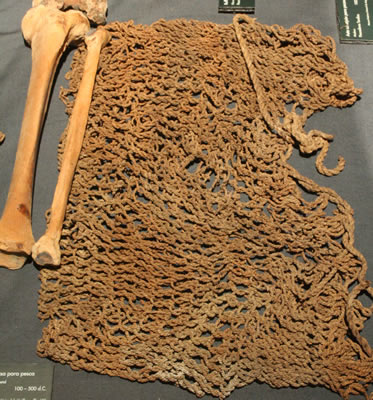Fishermen of the fog: The Changos and their ancestors-2008

Madejas de lienzas con nudos. Algodón. Pescadores Tardíos 100 - 500 d.C. Colección Museo Histórico Natural de Mejillones.

Soga con nudos corredizos .Cables torcidos , pelo humano y fibra vegetal. Pescadores Tardíos 100 - 500 d.C.
Colección Museo Histórico Natural de Mejillones.

"Chinguillo": Bolsa anillada para pesca. Fibra vegetal. Pescadores Tardíos 100 - 500 d.C. Colección Museo Histórico Natural de Mejillones.

a) Vaso troncocónico negro pulido. Cerámica. Cultura San Pedro 100 a.c.-400 d.C. Colección Museo Histórico Natural de Mejillones.
b) Botella gris café alisada.Cerámica. Estilo Quillagua-Tarapacá 100-500 d.C. Colección Museo Histórico Natural de Mejillones.

a) Vaso troncocónico negro pulido. Cerámica. Cultura San Pedro 100 a.c.-400 d.C. Colección Museo Histórico Natural de Mejillones.
b) Botella gris café alisada.Cerámica. Estilo Quillagua-Tarapacá 100-500 d.C. Colección Museo Histórico Natural de Mejillones.

a) Vaso troncocónico negro pulido. Cerámica. Cultura San Pedro 100 a.c.-400 d.C. Colección Museo Histórico Natural de Mejillones.
b) Botella gris café alisada.Cerámica. Estilo Quillagua-Tarapacá 100-500 d.C. Colección Museo Histórico Natural de Mejillones.

a) Cabezal de arpón para peces. Hueso de mamífero marino,espinas de cactus y algodón.
b) Asta de arpón para peces.Madera.
c) Cánula desangradora. Hueso de ave.
d) Rollos. Fibra vegetal torcida.
Pescadores Tardíos 100 - 500 d.C. Colección Museo Histórico Natural de Mejillones.

Cabezales de arpón para mamífero. Hueso de mamífero marino, barba de hueso, fibras de algodón y alga. Pescadores Tardíos 100 - 500 d,C. Colección Museo Histórico Natural de Mejillones.

Valvas de choro: Contenedores. Pescadores Tardíos 100 - 500 d.C. Colección Museo Histórico Natural de Mejillones.
(Español) Un pescador en Mejillones
The death of a fisherman from Mejillones some 1,500 years ago highlights the close relationship that was forged between the coast people and those of the inland oases.
This sea hunter, fisher and gatherer was buried alongside three other members of his community on the cliffside terrace of Las Loberas, on the Mejillones peninsula. His body is covered with pelican skins and accompanied by a set of special tools. The state of the skeleton shows that he spent most of his life living off seafood, and that he died from an accident at around 50 years of age. His grave goods included two polished black earthenware pieces and a finely made decorated basket. The ceramics are from the period 100-500 A.D., one from the oasis of San Pedro de Atacama and the other from the ravines of Tarapacá. The basket is representative of a style and tradition common among inland farming and pastoral communities. These discoveries bear witness to the long distance trade that occurred between the arid seacoast peoples and the inland farming and pastoral communities of the Atacama region, relationships that endured well into historical times.












































